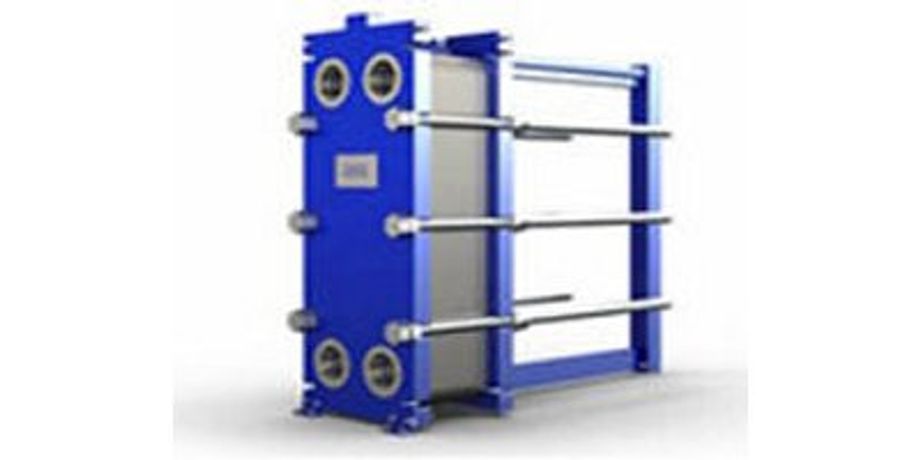
Gasketed - Plate Heat Exchangers
From Heat Exchangers
Gasketed plate heat exchangers (PHE) are a compact solution to almost all of your heat transfer needs. They provide for flexibility like no other heat exchanger in the industry today with a vast range of models with connection sizes ranging from 1' to 16'. A wide variety of plate materials are available such as stainless steel 304, 316 and titanium. Exotic alloys such as monel, Hastelloy and Nickel can also be provided for corrosive applications.
Advantages
- Because the flow pattern causes high turbulence of the fluids through alternate channels - this results in a higher heat transfer rate allowing for a more compact design reducing material cost since the heat transfer surface requirement is much lower than a conventional heat exchanger.
- High turbulence results in less fouling - therefore less down time for maintenance.
- Easily add capacity as expansion is required by adding plates to the heat exchanger.
- Can be opened without disturbing the piping
- Closer temperature approaches of up to 2°F maximizes heat recovery for a wide variety of applications
- Minimal space required for opening or closing the heat exchanger allows for easy maintenance
- Ideal for mounting on a skid
Flow principle of Plate and Frame Heat Exchangers
Plate and frame heat exchangers consists of a pack of thin metal plates with openings for the passage of the fluids. The plates are corrugated which means that each pair of adjacent plates in the heat exchanger forms a channel. Every second channel is open to the same fluid. Between each pair of plates there is a rubber gasket, which prevents the fluids from mixing and from leaking to the surroundings.
When the media enters the plate and frame heat exchanger via the connections in the frame, it's directed through alternate channels by the gasket arrangement. The warm fluid flows through every other channel and the cold fluid through the channels in between. Heat is thus transferred from the warm fluid to the colder fluid via the dividing wall, i.e. the plate material. The corrugations support the plates against differential pressure and create a turbulent flow in the channels. In turn, the turbulent flow provides high heat transfer efficiency, making the plate heat exchanger very compact compared with the traditional shell-and-tube heat exchanger.
The Double-Wall Plate Heat Exchanger
For fluids that must be kept separate
The Double-Wall Plate Heat Exchanger* is a technical breakthrough for heat exchange for media between which a hostile or undesirable reaction can occur, if the two fluids should mix. The Double-Wall Plate Heat Exchanger is therefore a new alternative to traditional heat transfer equipment such as the double-wall shell-and-tube heat exchanger, the triple-tube shell-and-tube heat exchanger, the double-circuit intercooler, and coils for indirect heating.
Design and construction
The Double-Wall Plate Heat Exchanger works on the same principle as a conventional plate heat exchanger but differs in that the single plates between the two media are replaced by plate pairs consisting of two identical plates stacked on top of each other and welded around the portholes. The channels then formed by assembling welded plate pairs in a plate pack are conventional channels sealed by gaskets in the traditional manner. In the unlikely event of leakage of any cause, one of the two media will always appear externally. Should a failure occur, whether it is related to the plate, gasket or seal weld, the ensuing leak will be easily visible on the outside of the heat exchanger.
For example:
- A hole in one of the double plates will result in external leakage from between the double-plate pair.
- A gasket defect will cause an external leak, either directly from the peripheral gasket or from the gasket vents open to the atmosphere.
- A defect weld will cause external leakage to appear either from the gasket vents or from between the plates at the site of the failure.
Advantages of the Double-Wall Plate Heat Exchanger
The Double Wall Plate Heat Exchanger, has many advantages over double-wall shell-and-tube heat exchangers:
- compact, small dimensions
- low weight
- low hold-up volume
- easy maintenance
- few inspections required
- easy to extend or reduce heat transfer area
- corrosion-resistance
- low fouling
- robust and reliable
- lower investment cost
- lower operating cost
Examples of duties for the Double-Wall Plate Heat ExchangerTransformer oil cooling
Water-contaminating transformer oil can result in severe damage to the transformer and can necessitate lengthy plant shutdowns.
Lube oil cooling
Oil which pollutes the cooling medium, whether it is sea, lake or river water, can cause severe damage to the environment and if the cooling medium mixes with the oil, serious damage can be caused to the equipment being cooled.
Quench oil cooling
Water mixing with quench oil can cause a steam explosion.
Potable water heating
District heating water, glycol, refrigerants and other heat sources used for heating potable water must not pollute the tap-water system.
Chemical processes
Intermixing of process media can create accelerated corrosion, an explosion, undesirable chemical reactions or contamination.
For example:
- An undesirable chemical reaction occurs if lauryl lactam or caprolactam intermixes with water, resulting in a miscolored product (fluorescence).
- Accelerated corrosion results in chlorated hydrocarbons intermix with water to produce hydrochloric acid.
Environmental protection
- Elimination of the risk of contamination of the cooling media in direct cooling systems.
- Replacement of existing secondary cooling systems.
- Waste water treatment with water of unknown composition allows thinner plate thickness.
Food and pharmaceutical processing
Product intermixing with the other media totally contaminates final products.
Alfa Laval® – thermal engineering pioneers
The Double-Wall Plate Heat Exchanger was developed by Alfa Laval in response to power stations’ problems of how to safeguard transformers from the risk of oil and water mixing, in case of heat exchanger failure. With the introduction of the
Double-Wall Heat Exchanger to the product range, Alfa Laval has extended the limits of the plate heat exchanger to new applications. This plate heat exchanger is just one of Alfa Laval’s thermal developments. Other recent developments are the graphite plate heat exchanger for highly corrosive liquids, the Semi-welded Heat Exchanger, a welded plate heat exchanger for high-temperature corrosive media, and the
Wide-Gap Plate Heat Exchanger, a plate heat exchanger for use with media containing fibers or coarse particles and with high viscosity products.
The latest in Alfa Laval’s product developments are AlfaRex, a gasket-free plate heat exchanger for higher temperatures and pressures, and the Steam Plate Heat Exchanger for general heating and cooling duties. Heating by means of steam.
Customer reviews
No reviews were found for Gasketed - Plate Heat Exchangers. Be the first to review!


